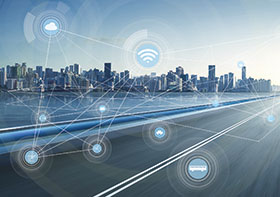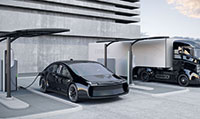

Power? Well, it comes out of a power socket. You get low-, medium- and high-voltage networks that bridge the vast distances to the generator – this is usually a large power plant.
Until now, this energy supply model has been the accepted norm worldwide but it is beginning to change.
The reason for this change is a growing trend towards decentralised supply concepts. Increasing numbers of alternative, distributed energy producers supply wind, biogas and solar energy to the network at various times and in varying amounts. Equally, new users have given rise to a finely ramified charging infrastructure with thousands of charging points for electric cars.
The existing energy distribution networks can barely meet these new requirements. Development needs to happen together with producers and consumers to create smart grids. These are intelligent, controllable networks that allow the challenges of the energy revolution, climate change and liberalised electricity markets to be met.
Connectivity is the core functionality of smart grids. By using them, it is possible to network equipment, systems and devices anywhere via the Internet. If these systems and components can quickly and safely communicate with each other, it is possible to bring them together to form virtual power plants and control them according to demand. New services can therefore be created, which in turn can form the basis of new business models.
Since the smart grid engineering systems communicate with each other directly via the Web (M2M), they are actually part of the Internet of Things (IoT). The technologies behind the concept are already known and generally widely available, so they are often just developed further or combined in a new way.
With its smart grid vertical market segment, EBV Elektronik is specifically targeting this growth market. The electronics distributor has divided the segment into the four core areas of energy generation, energy transmission and distribution, performance implementation, and the measuring and trading of energy, focusing on smart meters, energy storage units, adjustable transformers, generators for renewable energy, charging infrastructures for electric vehicles, and reliable, secure communications solutions for the smart grid.
Smart grids: at the heart of decentralised energy supply
The energy sector is faced with fundamental changes. The evidence of this is not only the ongoing phase-out of nuclear energy, but also the first ever electrical flat rate to be used in Germany. What has long been the rule for Internet connections and mobile telephone contracts, will soon be implemented in the energy market. How? Via the smart grid.
The intelligent energy network uses the progressive digitalisation of the components involved. However, in order to achieve this trend towards more decentralised and resource-efficient energy production and distribution, as well as the intelligent, energy-efficient use of energy, the various companies involved will need to radically rethink their approach.
Virtual power plants and flat-rate electricity
Let us take the example of SonnenFlat. Established in Allgau, energy system manufacturer Sonnen GmbH offers flat-rate electricity based on a community approach. Members invest in photovoltaic (PV) systems and home storage. Their batteries are networked digitally with one another and the resulting virtual storage can absorb energy from the power grid and return it at a later point. It therefore provides primary control energy, which can help compensate for fluctuations in demand, thereby stabilising the network. By marketing primary control energy, the provider earns money that is used to refinance the electricity flat rate.
This model assumes that members cover approximately 75% of their own electricity needs, while the remainder is supplied free of charge by the provider. It looks like this could be just the beginning for flat rate offers. Prof. Klaus-Dieter Maubach, former board member at E.ON SE, is certain that flat-rate, unlimited use offers will prevail in the long term in the energy sector.
This example illustrates the trend towards a more locally oriented energy supply. There is a vast spectrum of options for generating electricity, ranging from wind or solar systems and cogeneration or tri-generation plants, through to linking up decentralised producers in virtual power stations and the direct marketing of renewable energy.
Decentralised energy supply concepts can help to reduce the cost of network expansion. Because the electricity is produced and consumed on a local basis, there is no need to transport it over long distances. The logical expansion of this concept is controllable local network stations. Using these new transformers, the power can be fed from the low-voltage grid to the medium-voltage grid; an example usage for this might be utilising PV systems to supply an industrial area with energy produced in a neighbouring residential area.
The basis of virtual power plants and virtual storage is the smart grid. Only if the various units and components can communicate with each other securely and in realtime, are you able to link them together and control them. M2M communication takes place via the Internet.
The re-emergence of established energy suppliers
Established energy suppliers need to adapt to this change or risk going under. Consequently, they are already in the process of re-establishing themselves. The companies have split off their conventional energy supply sectors – coal, gas and nuclear power – and are shifting their focus towards sustainable technologies and renewable energy. Besides solar energy, wind power plays a major role and this results ever more frequently in the creation of offshore wind farms.

So, for example, E.ON and RWE (through subsidiary company innogy) want to focus on the lucrative business of clean wind and solar power, power grids and distribution. In any event, the smart grid is an important cornerstone in any new business models.
Wind turbines (WT) and entire wind farms have long been networked and communicating with each other via the Internet. It is here that the IoT can really play to its strengths, such as providing condition monitoring, for example. Sensors in the WT detect important technical parameters enabling the current status of essential components to be detected: certain patterns of vibration, for example, may indicate impending damage to bearings. In instances like this, the WT in question can proactively inform the control room and switch to a secure mode of operation. This means that maintenance can be initiated at an early stage before any actual damage occurs. These capabilities are particularly important for offshore installations where maintenance operations are much more complex than on land-based wind farms.
Electromobility: the need for a new charging infrastructure
The transportation industry is characterised by increased digitisation and electrification. This not only has an effect on private means of transport, but also on public passenger and freight transport, both on the roads and by rail. Vehicles are equipped with high-tech sensors and modules for data processing and communication, which allows the fleet to be better controlled and contributes to optimised maintenance operations. They are therefore also part of the IoT.

In addition, we are also seeing an increase in the availability of digital technologies and a change in the understanding of values of numerous people. In many cities, car-sharing providers are successful, not least because consumer goods like expensive smartphones are increasingly more important to young people than owning their own car. In the future, electric cars will more frequently be found in the carpools of car sharing firms and these vehicles will be permanently linked to the headquarters.
With entry restrictions for vehicles in urban areas becoming ever more stringent, and the Federal Council in Germany calling for the abandonment of combustion engines in vehicles by 2050, starting with the prohibition of the sale of gasoline and diesel vehicles in 2030, the electric vehicle market will continue to flourish and develop.
The effects of this are already visible: one example is Deutsche Post, which has begun to upgrade its fleet. To do this, the company purchased the Aachen-based electric car manufacturer StreetScooter in December 2014. In April 2016, StreetScooter Work began the series production of a van that is optimised for the delivery operations of the DHL parcel service. From 2017, approximately 10 000 vehicles will roll off the production line, with the possibility of supplying them to other customers. In the long term, Deutsche Post wants to convert its entire fleet of vehicles into an E-operation, with around 70 000 vehicles in total.
Without question, electric drives are much better suited to constant stop-and-go operations than gasoline or diesel. Because the delivery vans can be charged overnight, there is no time pressure on re-filling the batteries. This is a positive point as the rapid charging of energy reservoirs with direct current poses quite a challenge.
Until now, charging an electric vehicle with a 400 V three-phase AC power connection, or even a 230 V power outlet, has typically taken several hours. When it came to long-distance routes, there was therefore no alternative to electric drives other than internal combustion engines. Motorists are used to only taking a few minutes to fill their cars. So even spending 20 minutes to fill the energy reservoir, for example at a motorway service area, is too long.
By the time Porsche brings its first pure E-racer to the road – scheduled for 2020 – a more efficient, networked charging infrastructure must be available for use. The car is equipped with an 800 V battery instead of the usual 400 V one, and will charge at 1000 V and 350 A, which equates to around 350 kW. Later, new style connectors should allow charging at up to 500 A and inductive charging techniques are also a possibility. As part of the IoT, the vehicle could register in good time at the nearest charging station if energy reserves look to be depleted.
Operators of charging stations, such as those at rest stops, should already be thinking about how they want to meet the enormous demand for electrical energy in the future. What is clear is that the existing electricity production network was not designed for this. It is conceivable that a combination of conventional electricity and renewable energy sources, such as wind turbines and PV systems, might be put in place. These work together using a large buffer memory and provide large quantities of energy on a local basis. By digitally linking the components as part of a smart grid, the operation could be optimised.
Smart meters: the basis for intelligent network and resource management
Smart meters, in combination with smart meter gateways (SMGW), form the backbone of intelligent network and resource management in the energy sector. The devices can serve electricity, gas, water or heat meters. But their functionality goes far beyond that of meters that can be read at a distance.
In Germany, smart meters have been provided to major customers since the 1990s, and since 2010 they have also been offered to smaller companies and private households. A gradual roll-out in combination with SMGW has been planned for the future. From 2017, it will be available to customers with a consumption of more than 10 000 kWh/year and by 2020 for customers who consume more than 6000 kWh. An Internet connection is made available via the SMGW.
For a photovoltaic system to be used sensibly, particularly if used as part of a virtual power plant, an efficient energy storage solution is necessary. Today, these are based on lithium-ion batteries. The increase in mass production has led to a decline in price and subsequently improved profitability of these solutions. The storage reservoir also needs to communicate important status data regarding its capacity and current fill level via the SMGW. Correspondingly, what is necessary here is to find solutions that can reliably determine the charge level and subsequently transfer this information to the control room.
IT security in the smart grid: communication between power stations
The transparent, seamless and bidirectional transfer of energy-relevant information in real time is the basis of smart grids. More important still is the security of the system, which is decisive for the success of future smart grid applications.
Previously, power stations and operating control points have communicated via a standalone – usually wired – infrastructure. As decentralisation has progressed, this approach is no longer used. If, for example, several wind and PV systems formed part of a virtual power plant, it would be far too expensive to install an individual connection for each location given that these only serve the purpose of exchanging data with the control centre operator. Once again, the Internet provides the answer.
However, operators of old power plants find themselves in a dilemma. They need to open up their systems to the Internet, but the old communication infrastructure is frequently too precarious. Quite often they date from a time before the triumph of the Internet, when cybersecurity played little or no role.
In order that these networks are protected from cyber threats when connected to the Internet, gateways with very high security standards are needed, which prioritise the confidentiality and integrity of the data being transferred. For smart meter gateways in Germany, these security requirements are defined in the BSI TR-03109 technical guidelines. The security level of this standard is comparable to that of a credit card.
Without question, cybersecurity is the dominant theme for many companies in the energy sector. In addition to interoperability and standardisation, it is one of the fundamental market drivers for smart grids. The emphasis placed on this at EBV in terms of the portfolio and customer advice is therefore correspondingly high; for example, this is why EBV provides special security chips for IoT applications. These are used in a similar way to debit cards.
In a different way to applications in the healthcare sector, no personal data is transferred in the smart grid. Nevertheless, users must be protected against the misuse of technologies, such as illegal monitoring. Currently, more than 100 norms and standards of the IEEE-SA already describe and define intelligent electricity networks. In order to improve data protection and data security, however, further definitions and standardisation are still required. EBV supports its customers in this dynamic area, providing them with help, advice and finding solutions.
The role of EBV: intelligence for the smart energy grid
Smart grid applications are complex and increasingly software driven. They bring together features from completely different areas. For manufacturers, this means it is highly likely that the development of a product requires expertise from outside their own core competences, for example knowledge of connectivity or information security.
Instead of laboriously acquiring expert knowledge in wireless technology, embedded security, or other areas, the recommended way forward is collaboration with specialised partners, especially if they can come on board at an early stage of the development. With its extensive network of partners, EBV can build bridges and help its customers to find quick and appropriate resources and specific application knowledge.
A further challenge is the enormous variety of electrical components available. Finding the optimum components for an application is like looking for the proverbial needle in a haystack. It also costs valuable time. EBV has long-standing expertise in all fields of electronics and has an overview of the entire ecosystem, including design, software and manufacturing. By focusing on important, reliable suppliers, including some of the largest semiconductor manufacturers, the specialist distributor can work with its customers to quickly and precisely identify and select sensors, microcontrollers, power management and wireless modules that optimally suit the planned smart grid application. EBV customers therefore have access to the latest technology, and world class logistics ensure a smooth process flow, from planning to production.
For more information contact EBV Electrolink, +27 (0)21 402 1940, capetown@ebv.com
| Tel: | +27 11 236 1900 |
| Fax: | +27 11 236 1913 |
| Email: | saro.murabito@ebv.com |
| www: | www.ebv.com |
| Articles: | More information and articles about EBV Electrolink |
© Technews Publishing (Pty) Ltd | All Rights Reserved